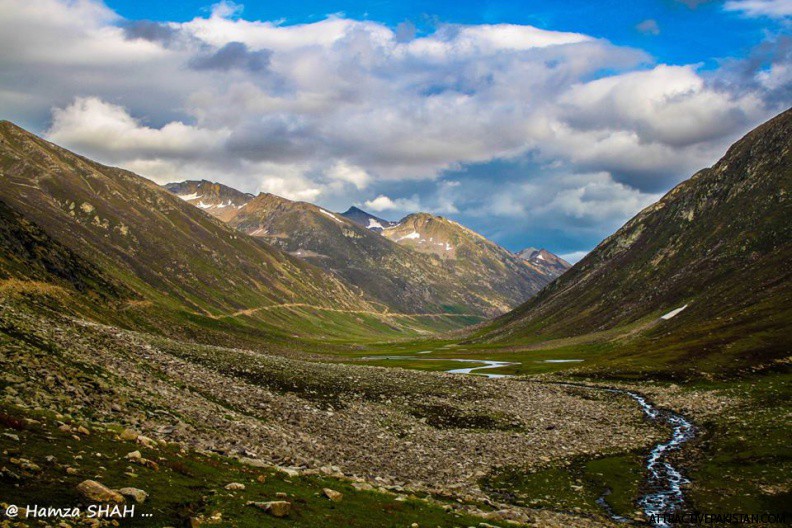Dudipatsar Lake
Dudipatsar Lake or Dudipat Lake is one of the most beautiful, stunning and mafnificent lakes which is encircled by snow clad peaks and lies in the extreme north of the Kaghan Valley. The word “dudi” means white, “pat” means mountains and “sar” means lake. This name has been given to the lake because of the white color of snow at surrounding peaks. In summer the water of the lake reflects like a mirror and the side valleys, specially the banks of the Lake become lush green. This lake is also called as Queen of Lakes due to its beauty.
The lake’s water is a beautiful greenish blue hue and very cold, at an elevation of 3,800 metres (12,500 ft). The surrounding mountains, with snow patches in the shady dales, average around 4,800 metres (15,700 ft) in elevation. Their natural habitat is in the Western Himalayan alpine shrub and meadows ecoregion. The lake and its wetlands habitats are of significant ecological importance for resident fauna and migratory waterfowl. Some of the park’s fauna includes the snow leopard, black bear, marmot, weasel, lynx, leopard, Himalayan snowcock, and snow partridge.
The lake and park is accessible for four months of the year from June to late September. In the summer, when the mirror-like water reflects the scenery, visitors from different regions of the country and from abroad travel to enjoy the enchanting views. The trail head for Dudipatsar is located at Besal, which is about an hours drive from the town of Naran and is accessible by cars and motorbikes. From Besal onwards visitors trek (as no jeep trek available) in vast alpine meadows to reach Dudiptsar Lake. It is advised to not track it in snow, as it is an avalanche prone area.
The Dudipatsar Trail is an approximately 18 km (11 mi) hiking trail, which starts at Besal. The trail goes along a tributary of the Kunhar River called Poorbi Narr in the northern Kaghan Valley. The headwater for the particular tributary is the Dudipat Lake. The average time taken to complete the trail is 5 to 8 hours. The trail passes through multiple life zones of the park, from lowland forests to alpine meadows of wildflowers. As the trail climbs up to the plateau, hikers see different wildlife in the region including marmots and different species of birds. During the course of the trail, one encounters boulders, meadows, plateaus, snow (in early summer) and streams.
Camping at Dudipatsar Lake and spending night can be so dreamy, that you don’t forget the galatic view of sky throughout your life.
Lulusar – Dudipatsar Natioanl Park Alpine Pastures are habitat of many internationally threatened Wildlife species and is rich in biological diversity where wide variety of wild animals, birds and migratory birds are found.In Lulusar Dutipatsar national park there are two types of fishes found in the lake. Some of the important fauna of the park are Himalayan ibex(Capra ibex sibirica), Brown bear(Ursus arctos), Marmot(Marmot flaviventris) snow leopard, (Uncia uncia), Important bird species of Lulusar Dutipatsar national park are Snow cock (Tetragallus himalayensis), Snow partridge (Lerwa lerwa), Himalayan Griffen vulture (Gyps coprotheresand), Himalayan Monal (Lophophorus impejanus) and Falcon(Falco jugger). Some the of the migratory birds come from Siberia to Lulusar Dutipatsar national during autumn and spring season. Important migratory bird species are Pintail (Anas Acuta), common teal (Anas crecca ), mallard (Ans platyrhynchos). As far as the flora is concerned, the entire area has lush green shrubbery which sprouts every year when the snow melts and covers the entire valley. You can easily find many herbs, trees and perennials of Himalayan Conifer forests. There are many medicinal plants found here such as Aspagol or Plantago ovate, Ban kakri or Podophyllun hexandrum, Thandi booti or Tussilago farfara, Chikee or Primula macrophylla. Shrubs include Grecian Juniper or Juniper exelsa, Jongi or Betula utilis, French marisk or Tamarix gallica, Sumbal or Barberis achycantha.





